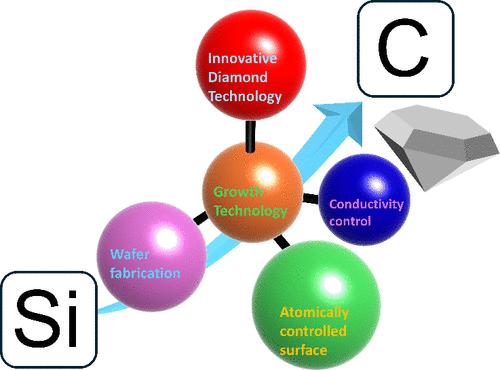当前位置:
X-MOL 学术
›
Acc. Mater. Res.
›
论文详情
Our official English website, www.x-mol.net, welcomes your
feedback! (Note: you will need to create a separate account there.)
Diamond Homoepitaxial Growth Technology toward Wafer Fabrication, Atomically Controlled Surfaces, and Low Resistivity
Accounts of Materials Research ( IF 14.0 ) Pub Date : 2024-08-13 , DOI: 10.1021/accountsmr.4c00123 Kimiyoshi Ichikawa 1 , Tsubasa Matsumoto 1, 2 , Takao Inokuma 2 , Satoshi Yamasaki 1 , Christoph E. Nebel 1, 3 , Norio Tokuda 1, 2
Accounts of Materials Research ( IF 14.0 ) Pub Date : 2024-08-13 , DOI: 10.1021/accountsmr.4c00123 Kimiyoshi Ichikawa 1 , Tsubasa Matsumoto 1, 2 , Takao Inokuma 2 , Satoshi Yamasaki 1 , Christoph E. Nebel 1, 3 , Norio Tokuda 1, 2
Affiliation

|
Strong covalent bonds provide diamond with superior properties such as higher thermal conductivity, electron/hole mobilities, and wider bandgap than those of other semiconductors. This makes diamonds promising for next-generation power devices, optoelectronics, quantum technologies, and sensors. However, there are still challenges in realizing practical diamond electronic applications. Key issues include controlling the microwave plasma chemical vapor deposition (MPCVD) growth process to achieve a large size, smooth surfaces, and desired conductivity. Standard semiconductor processing techniques like polishing and ion implantation also need improvement for diamonds. This Account outlines three MPCVD growth technologies being investigated at Kanazawa University to address these challenges.
中文翻译:

金刚石同轴生长技术,用于晶圆制造、原子控制表面和低电阻率
与其他半导体相比,强共价键使金刚石具有更高的热导率、电子/空穴迁移率和更宽的带隙等优越性能。这使得金刚石有望用于下一代功率器件、光电子学、量子技术和传感器。然而,在实现金刚石电子的实际应用方面仍然存在挑战。关键问题包括控制微波等离子体化学气相沉积 (MPCVD) 生长过程,以实现大尺寸、光滑表面和所需的导电性。金刚石所需的标准半导体加工技术(如抛光和离子注入)也需要改进。本账户概述了金泽大学为应对这些挑战而正在研究的三种 MPCVD 生长技术。
更新日期:2024-08-13
中文翻译:

金刚石同轴生长技术,用于晶圆制造、原子控制表面和低电阻率
与其他半导体相比,强共价键使金刚石具有更高的热导率、电子/空穴迁移率和更宽的带隙等优越性能。这使得金刚石有望用于下一代功率器件、光电子学、量子技术和传感器。然而,在实现金刚石电子的实际应用方面仍然存在挑战。关键问题包括控制微波等离子体化学气相沉积 (MPCVD) 生长过程,以实现大尺寸、光滑表面和所需的导电性。金刚石所需的标准半导体加工技术(如抛光和离子注入)也需要改进。本账户概述了金泽大学为应对这些挑战而正在研究的三种 MPCVD 生长技术。






























 京公网安备 11010802027423号
京公网安备 11010802027423号